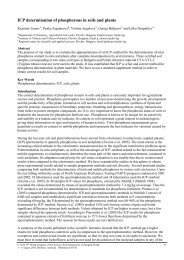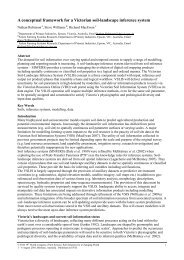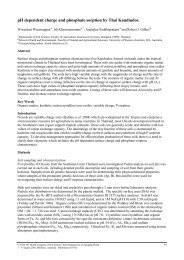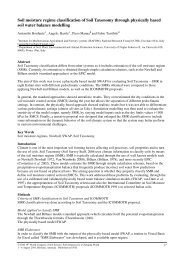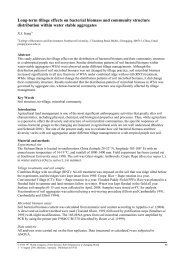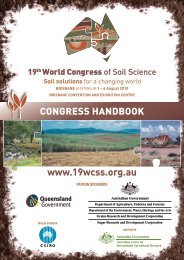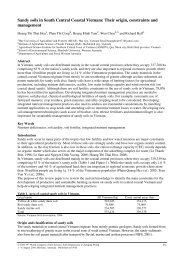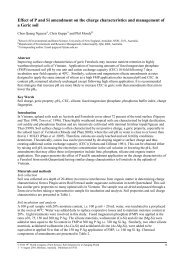Soil art - International Union of Soil Sciences
Soil art - International Union of Soil Sciences
Soil art - International Union of Soil Sciences
Create successful ePaper yourself
Turn your PDF publications into a flip-book with our unique Google optimized e-Paper software.
Bridging the gap: creative collaboration, opportunities, and challenges<br />
To address the idea <strong>of</strong> creative collaboration between soil scientists and soil <strong>art</strong>ists, we have been gathering<br />
opinions from both fields. In 2007, we drafted a questionnaire on soil science, aesthetics and <strong>art</strong>, which was<br />
distributed at the German <strong>Soil</strong> Science Society’s annual conference at a session on soil science, society and<br />
education and subsequently carried out at conferences in Australia, New Zealand and China. We asked<br />
members to share their opinions about the aesthetic properties <strong>of</strong> soil and their potential willingness to<br />
collaborate with <strong>art</strong>ists. 85% answered that they would be personally willing to cooperate with an <strong>art</strong>ist,<br />
while about 64% regarded the interdisciplinary direction <strong>of</strong> “soil <strong>art</strong>” as important. The results <strong>of</strong> this inquiry<br />
are included in our contribution to the book <strong>Soil</strong> and Culture (Landa and Feller 2010).<br />
In January 2010 we carried out fifteen in-depth interviews with ecological <strong>art</strong>ists who have worked with soil<br />
or soil conservation issues. Artistic formats included sculpture, ceramics, installation, illustration, painting,<br />
performance, video, graphic design, interactive or p<strong>art</strong>icipatory interventions, educational events, and<br />
landscape design. Environmental themes included moor degradation, acid mine drainage, rainwater<br />
harvesting, urban agriculture, pedodiversity, and coastal reforestation. Given this wide range <strong>of</strong> soil issues<br />
and <strong>art</strong>istic approaches, the topics <strong>of</strong> didactic aesthetics and restoration aesthetics came up in almost all<br />
interviews. Although most <strong>of</strong> the <strong>art</strong>ists answered that they thought about content first and then form, about<br />
half <strong>of</strong> the <strong>art</strong>ists felt that <strong>art</strong> should inspire through innovative form, rather rely too heavily on informative<br />
texts or educational props. One <strong>art</strong>ist described her <strong>art</strong> as a form <strong>of</strong> subservience – a service to community<br />
and environment. Other <strong>art</strong>ists spoke <strong>of</strong> their work as an ethical or spiritual duty to nature. All but one <strong>art</strong>ist<br />
described instances <strong>of</strong> collaboration, which differed when working with other <strong>art</strong>ists, scientists, city planners<br />
and educators. All <strong>art</strong>ists described an interdisciplinary nature to their work and expressed interest in<br />
collaborating with scientists, although most had already worked together with scientists and engineers.<br />
We are continuing our inquiry into collaborative science-<strong>art</strong> research with an extended questionnaire to be<br />
distributed in 2010 and 2011 at academic conferences and online venues. Further interviews as well as a<br />
more comprehensive analysis <strong>of</strong> completed interviews are also planned. A list <strong>of</strong> other projects,<br />
organizations, and <strong>art</strong>ists, can be found on our soil <strong>art</strong>s website, as well online platforms such as the green<br />
museum, eco <strong>art</strong> space and <strong>art</strong>s and ecology website (see references below). In a contemporary integration <strong>of</strong><br />
<strong>art</strong> and science, we must constantly examine the parallels that arise between an ever converging critical <strong>art</strong>world<br />
and a culturally literate scientific community. This is necessary for any attempt to combine soil<br />
science and <strong>art</strong>. Both fields must inform themselves <strong>of</strong> the others’ developments if they are to take p<strong>art</strong> in<br />
constructive dialogue. Conscious cross-referencing and frequent communication is needed. This is not an<br />
observation, but a call to action. Pr<strong>of</strong>essional <strong>art</strong>ists and cultural theorists should be invited more <strong>of</strong>ten to<br />
academic conferences, into laboratories, and to contribute to engineering and agricultural research, while soil<br />
scientists might <strong>of</strong>fer their expertise at environmental <strong>art</strong> symposiums, exhibitions and seminars.<br />
References<br />
Aagerstoun MJ (2007) ‘Eco<strong>art</strong> and Eco<strong>art</strong>ists’. http://www.sfeap.org/eco<strong>art</strong>eco<strong>art</strong>ists.html<br />
Bouma and H<strong>art</strong>emink (2002) <strong>Soil</strong> Science and Society in the Dutch Context. NJAS Wageningen Journal <strong>of</strong> Life<br />
<strong>Sciences</strong>. 50-2, 133-140.<br />
Bower S (2009) ‘A Pr<strong>of</strong>usion <strong>of</strong> Terms’. http://www.greenmuseum.org/generic_content.php?ct_id=306<br />
Feller, Lardy, Ugolini (2010) The Representation <strong>of</strong> <strong>Soil</strong> in the Western Art: From Genesis to Pedogenesis. In<br />
‘<strong>Soil</strong> and Culture’ (Eds Feller, Landa) pp. 3-21. (Springer Science + Business Media B.V.: Dordrecht,<br />
Heidelberg: London and New York).<br />
Greenland DJ (1991) The Contributions <strong>of</strong> <strong>Soil</strong> Science to Society – Past, Present, and Future. <strong>Soil</strong> Science 151,<br />
19–23.<br />
Herrmann L (2006) <strong>Soil</strong> education: A public need Developments in Germany since the mid 1990s. Journal <strong>of</strong><br />
Plant Nutrition and <strong>Soil</strong> Science 169, 464–471.<br />
Landa ER, Feller C (2010) ‘<strong>Soil</strong> and Culture’. (Springer Science + Business Media B.V.: Dordrecht, Heidelberg:<br />
London and New York).<br />
Matilsky B (1992) Ecological Art: A Response to Environmental Issues. In ‘Fragile Ecologies: Contemporary<br />
Artists’ Interpretations and Solutions’. (Ed Matilsky) pp.56-60. (Rizzoli <strong>International</strong> Publications, Inc.: New<br />
York).<br />
Minami K (2009) <strong>Soil</strong> and Humanity: Culture, Civilization, Livelihood and Health. <strong>Soil</strong> Science and Plant<br />
Nutrition 55, 603-615.<br />
Smiles DE, White I, Smith CJ (2000) <strong>Soil</strong> Science Education and Society. <strong>Soil</strong> Science 165, 87–97.<br />
Spaid S (2002) Reclamation and Restoration Aesthetics. In ‘Ecovention – Current Art to Transform Ecologies’<br />
© 2010 19 th World Congress <strong>of</strong> <strong>Soil</strong> Science, <strong>Soil</strong> Solutions for a Changing World 11<br />
1 – 6 August 2010, Brisbane, Australia. Published on DVD.



